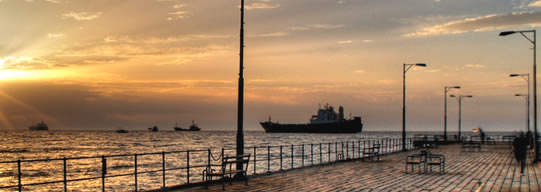
The Castle of Limassol (Lemesos Castle) as it appears today A is a structure rebuilt under the Turkish domination (19th century). The architectural features of a much more extended Medieval Museum have been included.
The oldest report on the existence of the Castle of Limassol dates back to 1228 when Frederick the Second of Germany and his supporters sent to prison the hostages seized by Ibeline, the king regent of Cyprus. This Castle was likely to be an ancient Byzantine Castle or the one that took its place over the early Frankish period. According to Stephen Lusignan, Guy de Lusignan had the original Castle built in 1193. This original fort, if it really existed, has not yet been localized by the archaeologists. It is more likely to have been given up to the knights for administration purposes on behalf of the crown in 1308.
In the corridor that links the big hall to the eastern grounds, B the basement was discovered in a log done before 1951. A marble podium of a small basilica dating back to the Early Christian times and the floor of a Middle Byzantine monument (10th – 11th century) were also discovered there C.
The eastern side of an arched basement composed of three parts has a big apse on the floor with an approximately 12-metre diameter which could be considered part of the first Latin cathedral of the town. The questions concerning the extent and the precise time when the monument had been erected will never be answered unless some excavations take place in the South and North side of the Castle. The winding staircase in the southwest corner was likely to be part of this chapel leading to its roof D.
The more recent division in three parts of the apse of this aisle with the arched roof could at least originally be considered a worship place too E.
In 1373 the Genoeses burned the town after having conquered the castle. At this attack serious damage must have been caused to the monument. According to the tourists the town had almost no inhabitants at the late 14th century. A small recovery was observed over the latest decade and the early 15th century at the Latin Bishop’s See of Limassol which apparently used a rebuilt old Middle Byzantine Temple, Zik-Zak street behind the today’s Kepir Mosque, while at the same time the Castle was being repaired. It is often featured that it was a place of resistance against the Genoeses in 1402 and 1408. In 1413 the resistance against the attacks of the Mamluks, who were eventually not able to conquer it, was a fact indeed.
Serious damage caused then and maybe a little later, owing to the earthquakes, which were not dealt with efficiently, made it easy to be conquered in 1425 by the Egyptians during their second raid conducted on the town.
According to some information a stronger earthquake affected seriously the monument. When in 1518 Saige visited the town, the Castle was still maintained in a strong position.
The most probable is what happened in the case of the Zik-Zak street temple during this period; repairs to a great extent and reconstruction works took place. The gothic arcs that can be observed in the ground western hall belong therefore to this reconstruction phase F. Also some openings with arch hewed doorframes are likely to be seen at the sidewalks of the first floor and above the today’s entrance G.
In 1538 the Turks landed at Limassol and conquered the Castle. Bragadino, the Venetian Governor of Cyprus decided to have the Castle demolished in order to prevent any further use of it or its being conquered by the Turks to be used as a fort.
Boustronios blamed the Governor for this act of his, stating that the expenses for the demolition of the castle went beyond the costs for having it repaired .The demolition works took place through several phases and their completion was achieved owing to the earthquakes occurred in 1567/8.
Following the complete conquest of the island (1576) by the Ottomans, the ruins of the old castle or parts of it were incorporated into the new fort built by the Ottomans in 1590. A 2-metre thick wall and the specially tailored ground floor cells used as a prison until 1950, have been two particularly important features of it.



